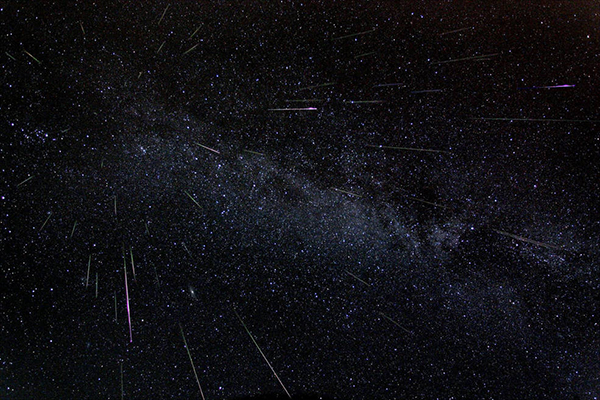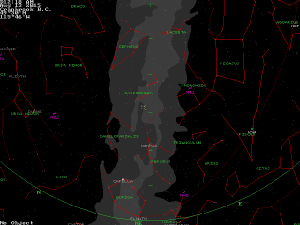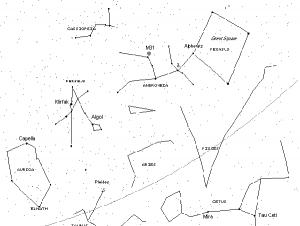Home »

Perseid Meteor shower underway
By Rick Nowell
The Perseid Meteor shower is here again!
The College of the Rockies’ meteor camera in Cranbrook has been detecting dozens of bright meteors falling the past few nights. This summer it is predicted to be more active than the usual maximum of 100 meteors/hour.
There are two peaks this year (according to the IMO International Meteor Organization) occurring on Wednesday afternoon and Thursday morning. The first peak occurs at 12:39 p.m. Aug. 12 when the Earth comes close to the 1862 passage of Comet 109P/Swift-Tuttle (the parent of the shower). The second peak is the usual yearly peak on Thursday, Aug 13 from 12:30 a.m. to 3 a.m.
The lead image is a photo of Perseus meteors by astronomer Fred Bruenjes; taking many 30 second exposures over a six hour period on 11 and 12 Aug 2004. Note the meteor streaks radiating out, and getting shorter the closer you get to the centre spot. Also note the glowing Milky Way band and dark clouds. (Source: NASA website).
Skies will be ideally dark, without the Moon’s glow to drown out the faint meteors. It takes the Earth a week to pass through all the ice and dust. The shower will gradually taper off and end by Aug. 24. The meteors are travelling at a speed of 59 km/s when they enter the Earth’s atmosphere.
Where to look?
 The composite photo (right) shows the entire sky, and all the meteors that fell on Aug. 12, 2012 over Cranbrook; taken by our college meteor camera. Perseus is the constellation to the northeast (middle left side of the photo). Normally there are fewer meteors seen straight overhead, since there is less volume of atmosphere overhead. There are slightly more meteors seen high to the west around Hercules and above the handle of the Big Dipper; since the meteor trails are longer there, and the meteors skim lower in a greater volume of atmosphere. That’s where I aim my cameras. Photo credit Rick Nowell, Cranbrook, BC.
The composite photo (right) shows the entire sky, and all the meteors that fell on Aug. 12, 2012 over Cranbrook; taken by our college meteor camera. Perseus is the constellation to the northeast (middle left side of the photo). Normally there are fewer meteors seen straight overhead, since there is less volume of atmosphere overhead. There are slightly more meteors seen high to the west around Hercules and above the handle of the Big Dipper; since the meteor trails are longer there, and the meteors skim lower in a greater volume of atmosphere. That’s where I aim my cameras. Photo credit Rick Nowell, Cranbrook, BC.

While you’re out stargazing, here is a star map (right) showing the Perseus region of the sky, looking Northeast late after midnight. The Milky Way band (grey in the map) runs through Perseus; who was the Greek hero coming to rescue Andromeda who is chained to the rocks. Look below the W of Cassiopeia (the Queen of Ethiopia). You should also see the great square of Pegasus, the winged horse to the right. If you have good eyes (or binoculars), you can spot the fuzzy cloud of the Andromeda Galaxy (M31 in the Map) just above Andromeda’s stick-figure knee. (Andromeda’s head is one corner of the square of Pegasus.) The Big Dipper, Little Dipper and Polaris are easy to locate to the left. (Starmap generated by Skyglobe software).
Some of the meteors seen will be from the k-Cygnids running from August 6–19. These peak on August 18 at 3 meteors per hour, although there is speculation that Aug 14 will show another peak. They show a number of slow falling fireballs moving at 25km/second.
 This 30-second exposure during the Perseids was taken late on Aug. 12, 2013 by Robert Ede up by Invermere. The camera is looking south towards Sagittarius in the heart of the Milky Way above the horizon. Aquilla the Eagle high above—the brightest star there is Altair, top center left. Look at the colours in the meteor streak—green as it starts ionizing the air then turning orange and red as it slows down.
This 30-second exposure during the Perseids was taken late on Aug. 12, 2013 by Robert Ede up by Invermere. The camera is looking south towards Sagittarius in the heart of the Milky Way above the horizon. Aquilla the Eagle high above—the brightest star there is Altair, top center left. Look at the colours in the meteor streak—green as it starts ionizing the air then turning orange and red as it slows down.
 Starmap looking to the Western horizon, with Sagittarius setting in the Milky Way band (a teapot shape).
Starmap looking to the Western horizon, with Sagittarius setting in the Milky Way band (a teapot shape).
The summer triangle of bright stars visible above as Vega, Altair and Deneb. And the handle of Ursa Major, the big dipper—follow the arc of the handle to Arcturus.
Source Link: imo.net/files/data/calendar/cal2015.pdf
Watch a NASA ScienceCast video on the 2015 Perseid meteor shower here: https://www.youtube.com/user/ScienceAtNASA
– Rick Nowell is the Physics Lab Technician at College of the Rockies, Cranbrook, B.C., Canada (49°31’03″N, 115°44’37″W, 940m)







